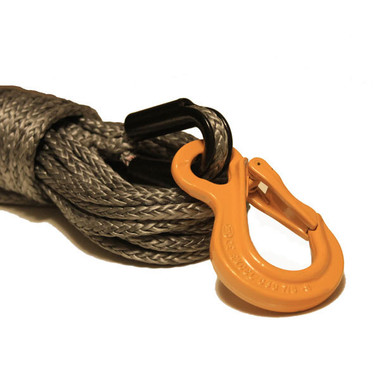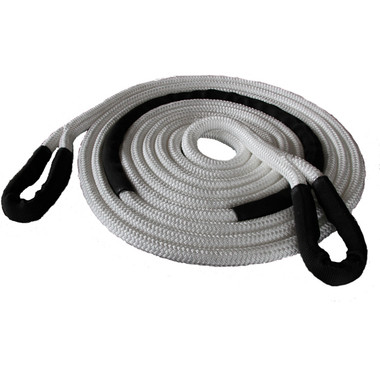Fellas we aint in 5000 lb jeeps ! the lightest duece to 5 ton trucks from 20 tp 30 k of pull if your on flat dry ground then add you being in mud or a hillside you just doubled your pull so were back to 40 to 50 k of line pull the synthetic rope would have to be as big as your wrist and i always go back to how many wreckers/cranes use synthetic line ? O
Doubling the line does not double the pull on each segment of line. As long as the line is rated enough (plus some safety factor) for your winch pull there is no issue, no matter how many pulleys you compound. Getting 50k of pull is as easy for 3/8 synthetic as it is for the 1/2 inch steel. I suppose you could replace the 1/2 steel with 1/2 inch synthetic, but that is rated to over 30k of line pull, which is just wasted space on a winch that can only pull 20k.
I can't really speak to why wreckers and cranes don't use it more, but I suspect it's a bit of "we've always done it this way". I suppose they might be concerned about a couple of the downsides to synthetic, which are the fact that it does not tolerate high heat, and it's way less abrasion/cut resistant. There is also some concern with the way the outer layers can plunge into the inner layers on the drum under load.
But in pretty much every other way, synthetic is better:
It's lightweight (and even floats). Ever had to swim out with 50 feet of 1/2 inch steel cable to recover a submerged vehicle?
It's smaller in diameter, allowing me to fit somewhere between 500 and 600 feet of line on a drum that only held 330 in steel cable.
It does not have a memory. Ever suck a kink into your winch using steel line? That sucks.
It does not snap back (as much). Breaking a synthetic line is much less likely to injure or kill someone when it lets go.
Easily spliced in the field. (I recommend the factor 55 FID for this) In a pinch, I can cut off sections from the main line and splice eyes on it in order to create the rigging needed to get me out of a tough spot. Cutting and splicing steel cable is a big hassle, especially with bigger diameters.
NO little steel splinters. Dang, I hate this things jabbing straight through my leather gloves into the meat of my hand. and those always seem to be really sore and infected in a couple of days.
I know I sound like a cheerleader for synthetic, but I switched my 12k Jeep winch over to synthetic a few years back, and I'll never do steel cable again. I use that thing a ton. One of the reasons I wanted to get the winch going on my LMTV, is because I've used that little Jeep winch so much, often time outpacing the Jeep's ability to stay put and once pulling over my anchor tree in an attempt to remove a big bush with a double line pull.
For me the benefits of synthetic far, FAR outweigh those of steel. I just try not to run it by anything sharp or hot.
But as always, you do you my friend.





